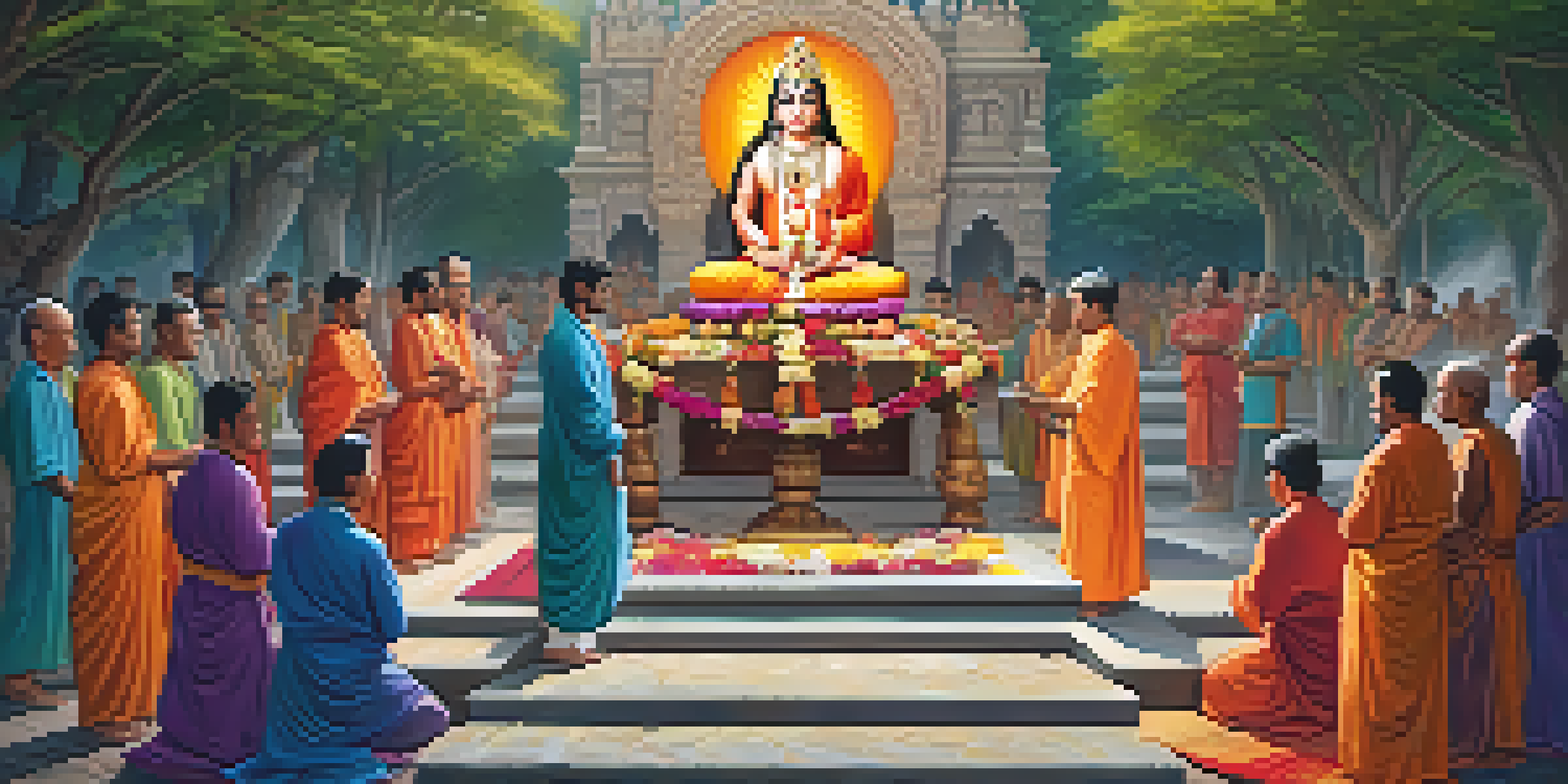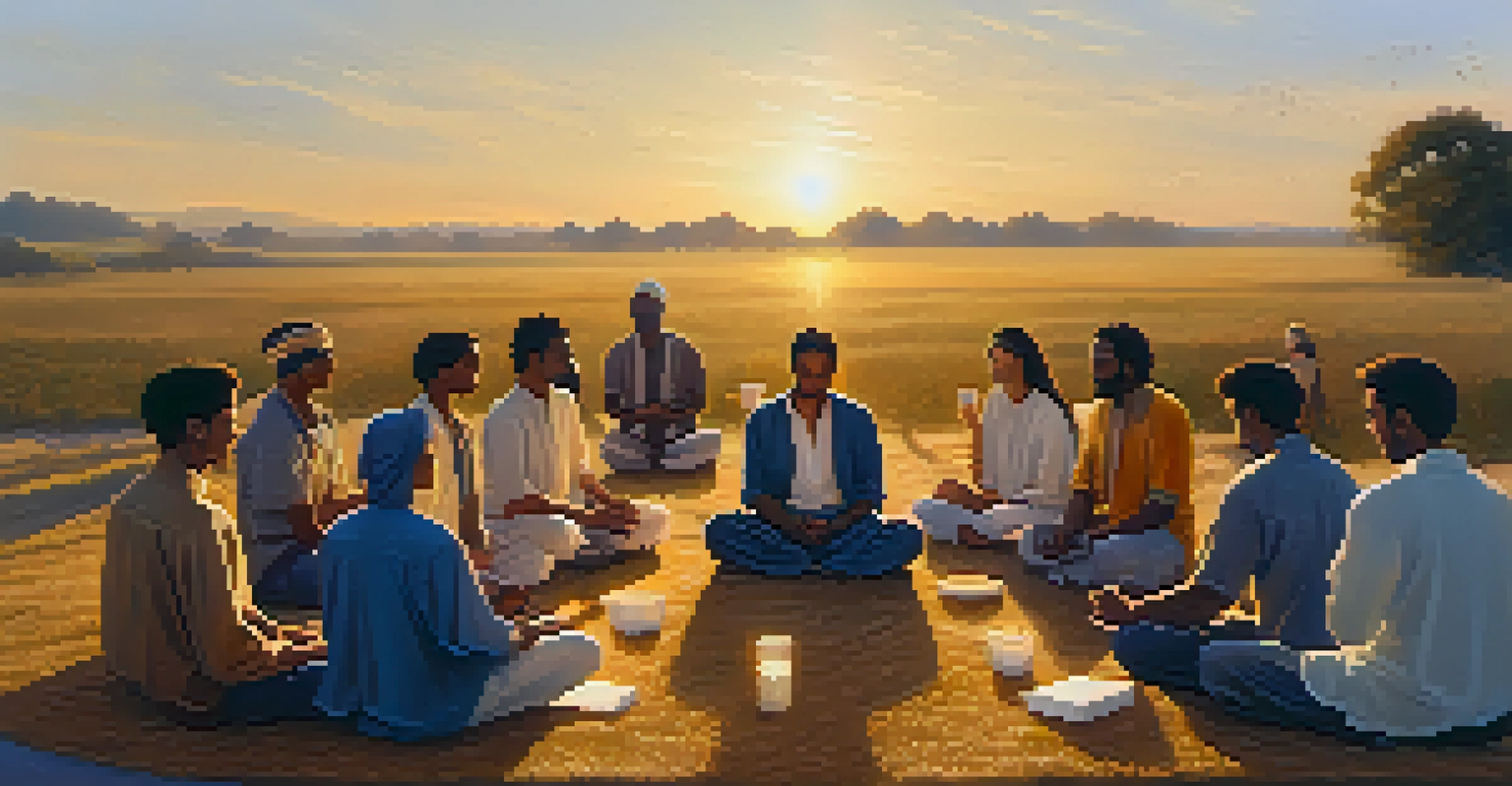Soma in Ancient Vedic Rituals: An Entheogenic Perspective

Understanding the Concept of Soma in Vedic Texts
Soma is a fascinating element found within ancient Vedic texts, often described as a divine drink or elixir. Its precise identity has long been a topic of scholarly debate, with some suggesting it could be a plant, while others propose it as a metaphorical concept. In the Rig Veda, one of the oldest sacred texts of India, Soma is often personified as a deity, representing both the drink and its transformative effects on the mind and spirit.
The mind is everything. What you think you become.
The descriptions of Soma highlight its significant role in rituals, where it was consumed to achieve heightened states of consciousness. This divine drink is portrayed as granting immortality and spiritual enlightenment, suggesting that its use was more than just a ceremonial act; it was a pathway to transcendence. The vivid imagery surrounding Soma in the texts indicates its importance in connecting the material and spiritual worlds.
In essence, Soma embodies a rich tapestry of meanings that extends beyond its physical form. It symbolizes the quest for divine connection and the experience of altered states of consciousness, which resonates deeply with the human desire for exploration and understanding of the divine.
The Rituals Surrounding Soma Consumption
In Vedic rituals, the consumption of Soma was a highly elaborate process, often involving prayers, hymns, and offerings. Priests would carefully prepare the drink, using specific plants believed to be associated with Soma, and perform rituals to invoke its divine properties. This meticulous preparation reflects the sacredness of the experience, emphasizing that Soma was not merely a drink but a means to engage with the divine.

The rituals surrounding Soma consumption also included communal aspects, where participants would gather to share in the experience. This collective participation highlights the importance of community in spiritual practices, as followers sought to connect not only with the divine but also with one another. The shared experience of consuming Soma fostered a sense of unity and purpose among the participants.
Soma as a Spiritual Catalyst
Soma represents a divine drink in Vedic texts that facilitates spiritual experiences and altered states of consciousness.
Moreover, the rituals were often accompanied by music and chanting, enhancing the sensory experience and allowing individuals to enter deeper states of consciousness. This multi-faceted approach to Soma consumption illustrates how ancient Vedic societies viewed spirituality as an immersive experience, engaging the mind, body, and spirit.
Soma's Possible Entheogenic Properties
The term 'entheogen' refers to substances that inspire a transformative experience, often involving altered states of consciousness. Many scholars propose that Soma, with its mind-altering effects, functions as an entheogen, facilitating spiritual experiences and insights. The idea that Soma could provoke such states aligns with the descriptions found in the Vedic texts, where it is linked to divine visions and revelations.
Nature does not hurry, yet everything is accomplished.
Research into various plants mentioned in ancient texts suggests that some may possess psychoactive properties. For instance, plants like the ephedra species or certain mushrooms have been considered candidates for identifying Soma. These substances may have been used to induce altered states, allowing practitioners to connect with spiritual realms and gain deeper understanding of the universe.
The entheogenic perspective on Soma invites us to consider how ancient cultures utilized natural substances to enhance their spiritual practices. This approach underscores the idea that the quest for divine connection often involves exploring the mind and its capabilities, a theme that resonates through many religious traditions worldwide.
Comparative Analysis with Other Ancient Cultures
The significance of entheogens in spiritual practices is not unique to the Vedic tradition; many ancient cultures incorporated similar substances into their rituals. For example, the use of peyote by Native American tribes and the consumption of wine in ancient Greek mysteries showcases a universal theme. Across cultures, these substances served as bridges to the divine, offering insights and transformative experiences.
By examining these parallel practices, we can appreciate the shared human experience of seeking connection with the divine. Just as Vedic rituals centered on Soma aimed for spiritual elevation, other traditions utilized their own entheogens to explore consciousness and existence. This comparative analysis highlights the profound role of natural substances in shaping spiritual beliefs and practices throughout history.
Rituals Foster Community and Unity
The communal rituals surrounding Soma consumption emphasize the importance of shared spiritual experiences among participants.
Such cross-cultural connections encourage a broader understanding of spirituality as a fundamental aspect of human life. They remind us that, regardless of cultural backgrounds, the search for meaning and transcendence is a shared journey, often facilitated by nature's offerings.
The Modern Interpretation of Soma
In today's world, the concept of Soma has evolved, often viewed through the lens of modern spirituality and psychedelics. Many contemporary spiritual seekers draw parallels between ancient practices and modern entheogenic experiences, emphasizing the potential for personal transformation. This modern interpretation invites individuals to explore consciousness in new ways, much like the ancient Vedic practitioners did.
Psychedelic research has gained traction, revealing the therapeutic potential of substances that alter perception and cognition. This resurgence aligns with ancient practices, suggesting that the exploration of consciousness is as relevant today as it was thousands of years ago. The modern perspective encourages a dialogue between ancient wisdom and contemporary science, fostering a deeper understanding of the human experience.
By embracing the lessons of the past, modern seekers can find inspiration in the rituals and practices surrounding Soma. This connection serves as a reminder that the quest for spiritual insight is timeless and that the exploration of consciousness can lead to profound personal growth and understanding.
Soma's Influence on Modern Spiritual Practices
The legacy of Soma in ancient Vedic rituals continues to inspire modern spiritual practices. Many contemporary movements incorporate elements reminiscent of Vedic rituals, such as communal gatherings and the use of natural substances to facilitate spiritual experiences. This revival reflects a growing interest in reconnecting with ancient wisdom as a means to explore consciousness.
Moreover, the idea of using rituals to enhance spiritual experiences resonates with various modern spiritual communities. Practices such as meditation, breathwork, and guided journeys often aim to evoke the transformative insights that Soma once provided. This synthesis of ancient and modern approaches fosters a deeper appreciation for the diverse paths to spiritual awakening.
Modern Reflections on Ancient Practices
Contemporary spirituality draws inspiration from Soma's legacy, exploring consciousness through rituals and natural substances.
Ultimately, Soma serves as a symbol of the enduring human desire for connection and understanding of the divine. Its influence on modern spirituality highlights the timeless pursuit of transcendence and the ways in which we can learn from the past to enrich our present experiences.
Conclusion: Soma's Enduring Legacy in Spirituality
In conclusion, the exploration of Soma in ancient Vedic rituals reveals a rich tapestry of spirituality and human experience. As both a substance and a symbol, Soma encapsulates the quest for transcendence that resonates across cultures and time periods. Its entheogenic properties and communal rituals illustrate the profound connection between nature and spiritual awakening.
The insights gained from studying Soma encourage us to reflect on our own spiritual practices and the ways we seek connection with the divine. By understanding the historical and cultural significance of Soma, we can appreciate the diverse avenues through which people have sought spiritual enlightenment. This reflection invites us to engage with the past while shaping our own spiritual journeys.

Soma's legacy continues to inspire modern seekers, reminding us that the pursuit of meaning and connection is a universal human endeavor. As we navigate our own paths, we can draw from the wisdom of ancient traditions, finding inspiration in the timeless quest for understanding and fulfillment.